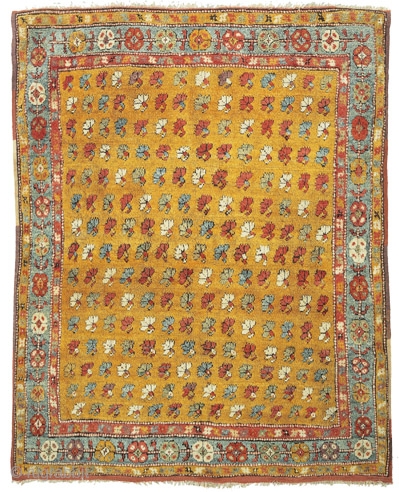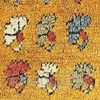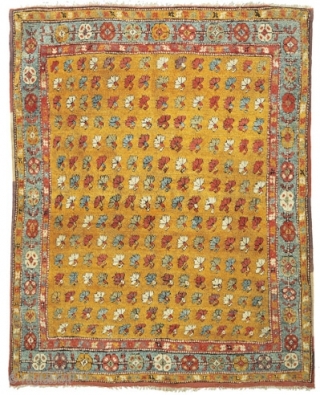Çal area, Menderes Valley
Southwest Anatolia
circa 1830
191 x 160 cm (6’3” x 5’3”)
Alg 1244
symmetrically knotted wool pile on cotton warps and wool wefts.
From the Turkish word for ‘bed’, yatak rugs are typically woven in a squarish format with a low knot count, having loosely spun, silky long piled wool on a foundation characterised by a number of weft shoots. An example with a similar pattern of stylised carnations on a dark yellow ground but with a different border has been ascribed to Konya (j.j. Eskenazi, L’Arte del Tappeto Orientale, Milan 1983, pl. 43, p. 127). Recent studies have shown however that there is a cohesive cluster of weavings from the Menderes valley in southwest Anatolia which display a plethora of motifs that are closely connected to the iconography of 16th and 17th century Ottoman carpets such as the Small Medallion Ushaks and the so-called Transylvanians (b. Morehouse, Menderes Valley Carpets, Hali 121, London 2002, pp. 100-107). The carnation represents one of the favourite floral motifs employed in Ottoman art in general, seen here in a joyous palette that exemplifies one of the most genuine manifestations of the Anatolian village rug tradition.
http://www.albertolevi.com/products_index.asp?TL=ENG&IDCat=44
- Home
- Antique Rugs by Region
- Category
- Profiles
- Post Items Free
- Albums
- Benaki Museum of Islamic Art
- Budapest: Ottoman Carpets
- Gulbenkian Museum
- Islamic Carpets. Brooklyn
- Islamic Textiles. Brooklyn
- Konya Museum: Rugs
- MKG, Hamburg
- MMA: Caucasian Carpets
- MMA: Mamluk Carpets
- MMA: Mughal Indian Carpets
- MMA: Ottoman Carpets
- MMA: Safavid Persian Carpets
- MMA: Turkmen Rugs
- McCoy Jones Kilims
- Ottoman textiles. Met
- Philadelphia Museum
- Rugs and Carpets: Berlin
- Seljuqs at the Met
- TIEM, Istanbul: Carpets
- V&A: Classical Carpets
- Vakiflar Carpets: Istanbul
- Baluch Rugs: Indianapolis
- Gallery Exhibitions
- Jaf an Exhibition
- Alberto Levi Gallery
- Andean Textile
- Christie's London: 2016
- Francesca Galloway
- HALI at 40
- ICOC Washington, DC 2018
- Jajims of the Shahsavan
- London Islamic Week April, 2018
- Mongolian Felts
- Navajo Rugs: JB Moore
- Persian Piled Weavings
- SF Tribal & Textile Art Show 2020
- SF Tribal 2019
- Sotheby's: C. Alexander
- Turkish Prayer Rugs
- Turkmen Main Carpets ICOC 2007









